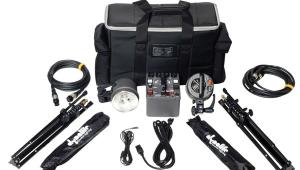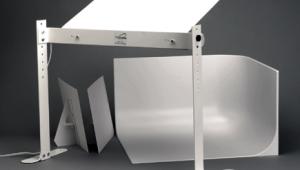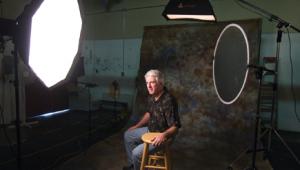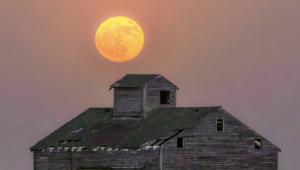Studio Flash Lighting; There’s A System To Fit Every Need Page 2
What Features Do I Need?
When it comes to monolights and power pack systems (excluding AC slaves), there
are numerous important considerations. Regardless of the type of studio-strobe
lights you buy, there are a number of features common to most, if not all.
High or low tech? High-tech systems with fancy digital displays come to you
at a price. They're also more costly to fix. And the places that fix them
may be limited. However, sophisticated computer circuitry ensures consistency
in output and color temperature. On the other hand, some low-tech, largely electromechanical
systems, with their conventional knobs and switches, have been known to last
years and to endure serious punishment. For a starter package, go low tech and
put the extra money into accessories.
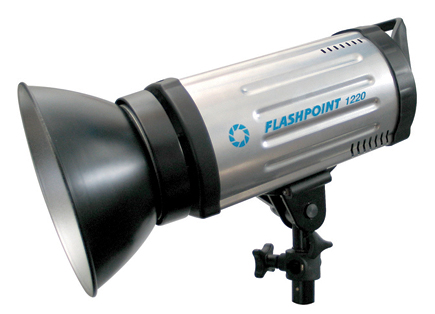 |
Flash head. While the flash head on a monolight is fixed,
there may be options even here in user-replaceable flash tubes and accessories.
Power pack systems offer a wide variety of available heads (each adding to the
overall cost), making them more versatile. Special types of heads are uniquely
suited to different applications. A beauty dish, for instance, throws a soft,
flattering light used in beauty photography. A ring flash head, which is larger
than the typical macro ring flash but is similarly fitted to the front of the
camera, also finds use in beauty and portrait photography. A bi-tube head throws
off a large quantity of light, but may need two packs to power it. The list
seems endless.
Reflectors. Flash heads, whether hooked up to a power pack
or integrated into a monolight, generally feature an interchangeable reflector
(bowl or dish) used to shape the light. More compact units may come with a built-in
reflector. Interchangeable reflectors give photographers numerous options. For
one, bare-bulb photography, which produces an even light around the entire room,
reminiscent of sunlight. Certain reflectors are designed to accommodate a photographic
umbrella, whereas many heads require an accessory replacement dish for this
purpose. The shape of the bowl and its finish also determine the throw of the
light and its quality.
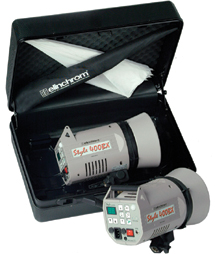 |
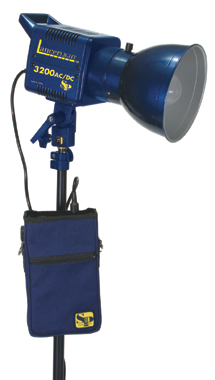 |
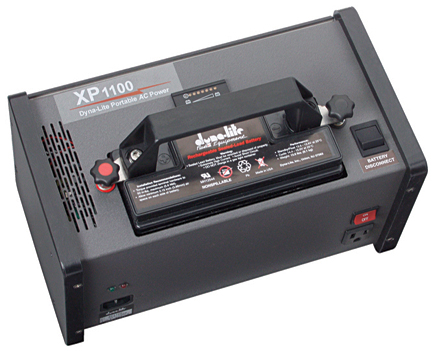 |
|
Flash tube. Flash tubes are normally user-replaceable. Aside
from replacing worn bulbs, you may want to substitute a UV-corrected tube for
the one that routinely comes with the unit, for improved daylight color balance.
There may be a heat limitation. One manufacturer, for example, routinely fits
their 1600 ws flash heads with a UV-corrected flash tube, whereas 3200 ws tubes
would burn off the coating. So the UV coating is instead applied to the protective
dome, which may be a further element helping to control the light (but more
importantly is there as protection against a shattered bulb/tube).
The modeling light. The decision maker may come down to the
modeling lamp, or lack thereof. The modeling lamp is an essential ingredient
in studio lighting. It lets us preview the lighting effect (to judge contrast
and where shadows fall) prior to making the exposure. This is usually an incandescent
bulb, normally a long-life halogen (tungsten or quartz) or as simple as a household
light bulb, or fluorescent in flat-panel lighting. Whereas many modeling lights
are 250w (serving also as low-output hot lights with tungsten film), others
may be of considerably lower wattage and less suitable in relatively bright
ambient surroundings. Modeling lamps should ideally quench (or at least dim)
when the strobe is fired so as to not affect the lighting, and output should
vary directly (proportionally) with strobe output, to better enable you to judge
the effect, with the option to turn them off entirely or set them at full when
needed.
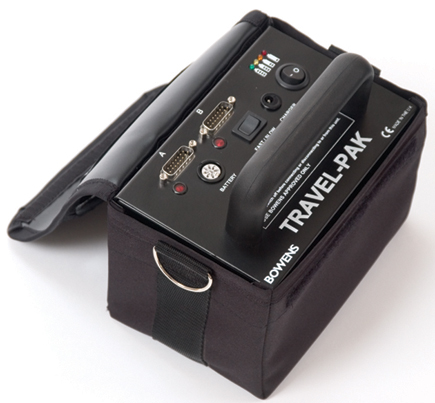 |
Built-in slave sync. Increasingly, more sophisticated systems
are integrating a radio-remote wireless capability. But practically every power
pack and monolight has a built-in photocell, and some have infrared triggering
capability. For everyday use, anything with a photocell will do.
Stepless power output. If output cannot be varied steplessly,
or at least in 1/3 steps, you may find yourself physically moving the light
closer or farther away more often than you'd like. Keep in mind, however,
that stepping down power is often accompanied by a color shift in light output
toward blue (with shorter flash duration and faster recycling).
Recycling time. The faster the better, but that depends on
your needs. You can shorten recycling by reducing output.
Accessories. A photographic umbrella or softbox (each resulting in a different
type of soft light), barn doors (to prevent light spilling onto unwanted areas),
and grids (for tighter light coverage) are just a few of the options. Because
it operates
off-camera, the flash head or monolight requires a light stand. Make sure that
it's one suitable to the load. Heads with strong incandescent modeling
lights should be fan-cooled (an important consideration when using a softbox).
Remote operation. In this increasingly sophisticated age,
it's not enough to centralize control of the lights in one box or on a
monolight. Now, we want to remotely control everything. Remotes are optional
accessories that let you remain at the camera position, so that you can better
visualize the combined effect of multiple lights on the subject. More and more
systems now also feature computer control, requiring a desktop or notebook computer
(PC or Mac) and special software.
Keep this in mind: You don't need to buy everything all
at once. Build the system as needs emerge. Many pros successfully work with
only one or two lights. It may even be possible to rent a system, so you can
get a feel for what works best for you and your type of photography.
Match Your Lights And Lighting Accessories To Your Needs
Studio portraiture. The lights don't have to be more
powerful than 400 ws. Often, one light will do, plus a white photographic umbrella
(which produces a softer, more neutral light, compared with silver umbrellas,
which tend to go cool). Add a second light for the background or as a hair,
accent, or fill light. In a pinch, the camera's built-in flash will do
as fill, while also triggering the studio strobes (via their built-in slave
cells). More powerful lights, say 800 ws, will ensure greater depth of field.
You'll only need something even more powerful, for even more depth of
field and with faster recycling, if you're shooting fashion or groups
of people. Now, the question becomes: power pack system or monolight? The simplest
answer is a monolight. One often works wonders. A flat-panel AC monolight is
great for head-and-shoulder portraits, with a fill card to reduce contrast.
 |
Tabletop/still life/food. Stopping down to small lens apertures
is often required, though not always. You should consider one 800 ws light for
starters, more if you can afford it. A softbox is a wise addition. As your photography
grows more sophisticated, you'll add to this, with more lights and such
things as honeycomb grids and barn doors, both of which control the spread of
light. You might also want a diffusion housing (a cube-shaped or rectangular
light tent, for instance) to further reduce contrast. I've found flat-panel
self-contained strobes work well here, and these lights don't require
a softbox or umbrella.
Interiors. If you're simply lighting a room or just some
furnishings, then three lights will do as starters. The choice here is a power
pack system. The downside: If you need to space the lights far apart--or
to optimize the output generated by the power pack, you might need to use one
pack per flash head--and that translates not only into greater initial
cost but a need to find outlets that don't run off the same circuit breakers,
to avoid shorting out the lights. Here umbrellas are an economical way to spread
the light out evenly over a large area, or you can use 4x8-foot white foamcore
flats (panels) as a bounce light source. Obviously, little nooks and crannies
may need more light. And that's where small AC-powered slave strobes come
in, hidden out of camera range. These small lights may have to be finessed with
some diffusion to avoid hot spots.
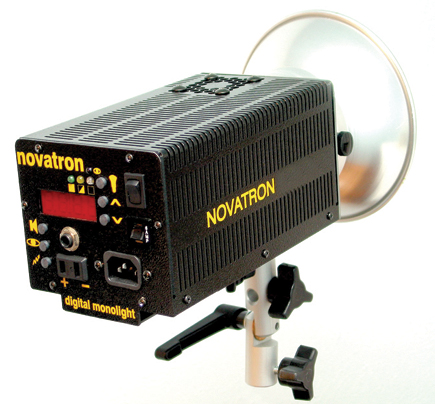 |
Location portraiture. In someone's home, one or two
monolights will fit nicely, with umbrellas. Again, find separate outlets to
avoid an electrical short. However, when shooting fashion on location, power
packs often work best. You may need several packs and several heads to achieve
the necessary results. If you're doing something like a wedding or executive
portraits outdoors, then a battery-operated flash will do--either a power
pack or monolight, or one of those smaller battery-pack handle-mount-style systems
(from Quantum, Lumedyne, or Norman, for example). If you expect to be shooting
on location, away from AC outlets, consider a mobile pack system or battery-operated
monolights.
Shooting digitally. The lighting has to be even more consistent
here than with film, both in terms of color balance and output. Digitally-controlled
lighting systems, especially those connected to a computer, may work best, but
they're often expensive. Anything that performs consistently will do.
When dealing with digital backs on medium or large format cameras, the software
(that came with the back) may dictate certain procedures for achieving optimum
color balance. Many camera systems require a maximum 6v sync voltage to trigger
the strobes safely.
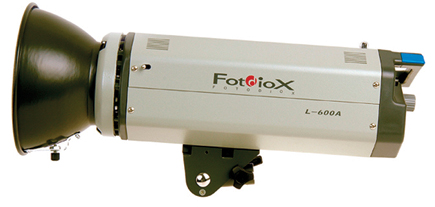 |
Traveling With Your Lights? Consider The Following...
I can load up my SUV. Then go with power packs. Don't
forget the various reflectors, stands, and other grip equipment, umbrellas,
softboxes--and possibly extension cords. I'm assuming you'll
have an assistant to help you set up and break down the lights. And be sure
to bring gaffer's tape, in case wires have to be taped down so people
don't trip over them.
I can take a cab. Load up one case with whatever fits. This
may be a small power pack and two heads, or two compact monolights--with
stands. You might have to leave the softbox at home and make do with umbrellas
(there are, however, some softboxes that are almost as compact as umbrellas
and attach to a head in a similar fashion). Camera and lenses should be in a
separate case.
- Log in or register to post comments






